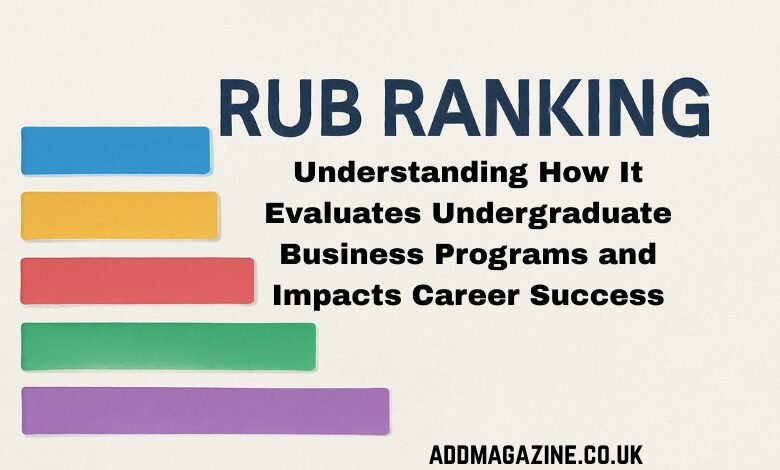The term “RUB ranking” might sound unfamiliar to many, but in certain fields, it holds a particular significance. RUB, in this context, stands for Ranking Undergraduates for Business, a model used in evaluating and ranking universities or colleges based on their undergraduate business programs. The RUB ranking system is essentially a metric or a comparative tool used to assess the quality, reputation, and success of business schools or specific undergraduate programs related to business management. This type of ranking is often derived from several factors, such as the academic performance of students, faculty quality, the resources available for learning, alumni success, and even the program’s global impact.
To give a broader view, RUB ranking shares many similarities with other university ranking systems, but it focuses primarily on undergraduate business education. The aim of RUB ranking is to provide potential students and educational bodies with an easy-to-understand framework for comparing institutions. This ranking helps students choose the best programs based on their academic and career goals. RUB rankings can also help universities benchmark their business programs and implement strategies to improve their educational quality.
This post will explore what RUB ranking is, how it works, and its significance in the broader educational landscape. It will also provide insights into how institutions are ranked, what metrics are used, and how students can leverage RUB rankings when making decisions about their education and future careers.
What is RUB Ranking?
The RUB ranking refers to a system used to measure and rank undergraduate business programs based on several academic and non-academic factors. It is often used by students, academic institutions, and educational bodies to assess the standing of business schools or undergraduate business programs globally.
These rankings are derived from various factors that combine both objective measures and subjective opinions from different stakeholders, including students, alumni, faculty, and employers. Similar to other higher education rankings such as QS World University Rankings or Times Higher Education, RUB ranking provides a comparative analysis of business programs across different institutions. However, RUB is specific to undergraduate business education, focusing on programs that lead to degrees in business administration, management, economics, and related fields.
How RUB Ranking Works
RUB rankings are typically based on a combination of the following key factors:
- Academic Reputation: This is one of the most significant factors in determining RUB rankings. Academic reputation takes into account the quality of teaching, the curriculum, faculty qualifications, research output, and the institution’s overall academic standards.
- Student Satisfaction: RUB rankings often consider the satisfaction of students currently enrolled in business programs. Surveys and feedback from students regarding the learning experience, campus life, access to resources, and faculty engagement play a vital role in the ranking process.
- Post-Graduation Employment Rate: One of the primary goals of a business program is to prepare students for the workforce. As such, RUB rankings look at the employment rate of graduates within a certain period after completing the program. This includes the quality and types of companies hiring graduates, job placement support, and alumni success in the business world.
- Internationalization: RUB rankings may also measure the international exposure provided by the business program. This can include opportunities for international internships, exchange programs, and the diversity of the student and faculty body. Business schools with a global perspective and network often score higher in this category.
- Research Output and Impact: The level of research conducted by faculty and students is an essential part of the RUB ranking process. Institutions that encourage research projects, publications, and academic partnerships often rank higher due to their contributions to advancing knowledge in business and management fields.
- Alumni Network and Success: The success and impact of alumni in the business world also factor into RUB rankings. This includes alumni achievements in leadership roles, entrepreneurship, and corporate success. A strong alumni network provides both inspiration and resources for current students, making it a crucial aspect of ranking.
- Faculty Expertise: The qualifications and expertise of faculty members are also an important consideration in RUB rankings. This involves factors such as the faculty’s educational background, professional experience, research contributions, and teaching methods. High-caliber faculty members contribute significantly to the overall academic quality of the program.
- Resources and Infrastructure: The availability of resources such as state-of-the-art facilities, libraries, technology, and financial support also influences RUB rankings. Institutions with modern classrooms, learning tools, and a strong support system for students and faculty typically rank higher.
The Importance of RUB Ranking
RUB rankings hold great significance for multiple reasons. Here’s why they are essential:
- Informed Decision-Making: For prospective students, RUB rankings offer valuable insights into the quality and reputation of undergraduate business programs. Students can compare different institutions and programs, helping them make more informed decisions about where to apply and what program to pursue based on their preferences, career goals, and academic interests.
- Improving Institutional Quality: RUB rankings are not just beneficial for students. Educational institutions also use these rankings to assess their strengths and weaknesses. A detailed ranking system provides insights into areas that need improvement, helping institutions allocate resources more effectively and enhance their academic offerings.
- Global Recognition and Reputation: For business schools, being highly ranked in RUB is a sign of global recognition and prestige. This recognition helps attract top-tier students, faculty, and employers, enhancing the institution’s reputation. High rankings are also indicative of an institution’s capacity to produce high-quality graduates who contribute to the global business landscape.
- Employer Perspective: RUB rankings also help employers identify top talent. Many employers, especially those seeking fresh graduates for management roles, use rankings as a guideline for hiring decisions. They often prefer candidates from highly ranked institutions as they are perceived to have received a quality education and possess skills relevant to the industry.
Top Factors That Influence RUB Ranking
The RUB ranking system uses a wide range of metrics to evaluate and rank undergraduate business programs. These metrics can vary from one ranking publication to another, but they often include the following:
- Accreditation: Accredited programs are generally held to higher standards, which is why they are highly regarded in RUB rankings. Internationally recognized accrediting bodies, such as AACSB, EQUIS, and AMBA, are indicative of a program’s credibility and quality.
- Faculty-to-Student Ratio: A lower faculty-to-student ratio often signifies a more personalized learning experience. It means that students have more opportunities to engage with faculty members, participate in discussions, and receive individualized attention.
- Financial Resources: The level of funding available to support business programs, including scholarships, research grants, and the ability to hire top faculty members, is a significant factor in rankings.
- Student Diversity: A diverse student body enhances the learning environment and fosters a global perspective. Institutions with higher diversity often score better in RUB rankings because they provide a dynamic and inclusive educational experience.
- Internship and Practical Learning Opportunities: Hands-on experience in the form of internships, consulting projects, or case studies is crucial for business students. Programs that offer robust opportunities for real-world experience tend to rank higher.
- Global Network and Partnerships: Business schools that are well-connected with multinational corporations, international universities, and business organizations have an advantage in RUB rankings. This network provides students with opportunities for internships, jobs, and cross-cultural learning experiences.
Criticisms and Limitations of RUB Ranking
While RUB rankings are helpful for many students and institutions, they are not without their criticisms. Here are a few limitations:
- Overemphasis on Reputation: RUB rankings often place significant weight on institutional reputation, which can sometimes overlook the quality of teaching and the personal learning experience of students. As a result, some highly ranked institutions may not always provide the best educational experience for students.
- Limited Scope: RUB rankings tend to focus on specific factors, such as post-graduation employment rates and academic research. However, they may not always capture other important aspects of a business program, such as the depth of specialized courses, teaching quality, or student well-being.
- Subjectivity of Rankings: Like many other rankings, RUB rankings often involve subjective opinions, particularly in surveys of employers, alumni, and faculty. These opinions may not always reflect the true quality of the programs, as they are influenced by individual perspectives and biases.
How to Use RUB Ranking Effectively
Students can use RUB rankings effectively by considering the following:
- Identify Personal Priorities: Understand what is most important to you in a business program. Do you prioritize a strong alumni network, internship opportunities, or academic rigor? RUB rankings can help you identify schools that excel in the areas that matter most to you.
- Consider Your Career Goals: Look for programs that offer a curriculum aligned with your career interests. RUB rankings can highlight programs with strong specializations in areas such as marketing, finance, or entrepreneurship.
- Look Beyond the Numbers: While rankings are helpful, don’t rely solely on them. Visit campuses, speak with alumni, and evaluate other factors like the faculty, student life, and overall culture of the institution.
Conclusion
RUB ranking serves as a valuable tool for evaluating undergraduate business programs. It provides prospective students with a clear, comparative analysis of institutions based on factors like academic reputation, employment outcomes, resources, and faculty expertise. Although it has its limitations, RUB ranking can still help students make informed decisions about where to pursue their business education. For educational institutions, these rankings offer a chance to assess their performance and continually improve. Ultimately, RUB ranking provides a snapshot of business education quality, helping students and institutions thrive in the competitive global landscape.




